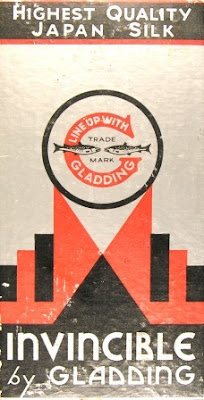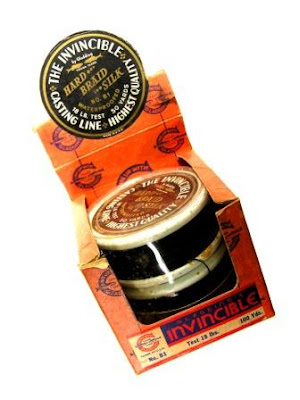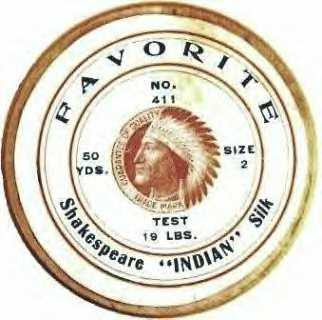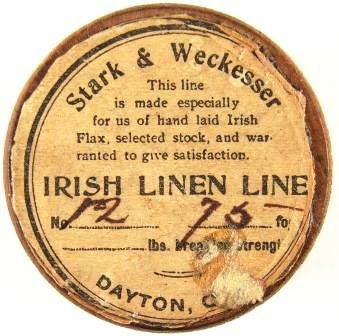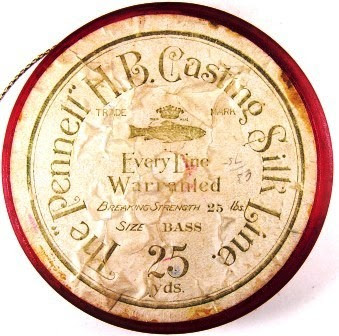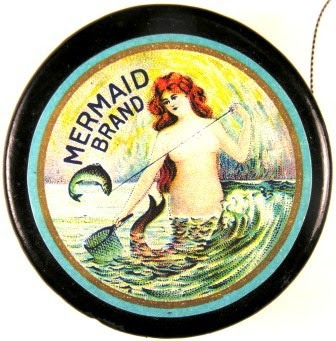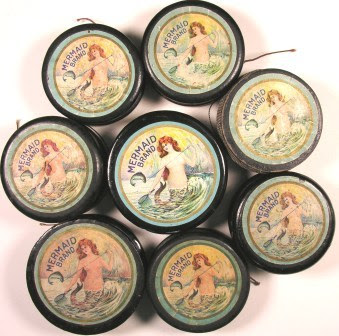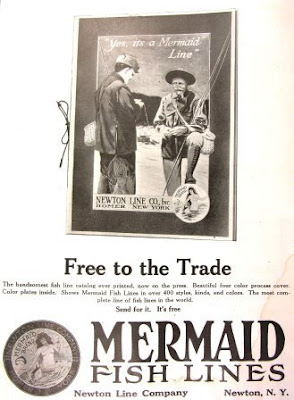 Newton's David Harum
Newton's David Harum
One of the reasons that I like to collect vintage fishing lines is the opportunity that it provides for me to learn more about them. I like to research the company names and brand names that appear on the labels to see what more I can discover about their history. Almost every line spool label that I have ever researched has inevitably had a story to tell me. From fishing line labels I have learned about some very special and historical geographical places in our Nation, and I have learned about many famous Indian tribes, and I have learned about many mythological and fictional characters as well as real people like U. S. Presidents and others who were famous fishermen.
 Boxed pair of Cortland's Cardiff Giant
Boxed pair of Cortland's Cardiff GiantI have learned quite a bit more about the tackle industry, and American history in general than I ever knew before I started researching line spool labels. I have learned more about the companies, people, places, events, politics and pop culture that collectively tell us stories not only about fishing history and the American Tackle Industry, but also about the history of our nation as well. For me, discovering these stories that are hidden behind the brand names on line spools has added immensely to the pleasure I have received from collecting those vintage and antique fishing lines.
 The original Cardiff Giant being dug up
The original Cardiff Giant being dug upAn example of what I am talking about can be found in two brand names that have a connection to both history and to each other. They are the Newton Line Company's "David Harum" and the Cortland Line Company's "Cardiff Giant".
1869 Flyer to see the Cardiff Giant in Albany
The Cardiff Giant fishing line takes its name directly from the Cardiff Giant Hoax of 1869, which is still considered to be one of the greatest hoaxes of all time.

Cardiff Giant being exhumed on August 16, 1869
In 1869, New York cigar maker George Hull had a block of gypsum carved into the likeness of a man over 10 feet tall. It was artificially aged, then buried on the Cardiff, N.Y., farm of Hull's confederate and cousin in the scheme, William Newell, who then arranged for it to be "discovered" by workmen digging a well on his property. Its discovery was heralded as a great geological find of a huge petrified man, and proof of the Genesis verse: "There were giants on the earth in those days…" People, including the rich, and powerful, and famous individuals of the day flocked in great numbers from all over the Nation to see the giant for a mere 50 cent admission charge. When showman, P. T. Barnum, saw the large crowds paying money to see the giant, he decided he wanted to buy it to put in his museum of oddities. When Hull and his financier, banker David Hannum refused Barnum's offer of $30,000.00 to buy it, Barnum simply had a copy made and declared their giant to be a phony and declared his giant to be the original.
 P. T. Barnum's Poster of the Cardiff Giant
P. T. Barnum's Poster of the Cardiff Giant
The Cardiff Giant hoax was the incident that inspired "There's a sucker born every minute" quote, but P. T. Barnum didn't say it. One of Hull's partners in the hoax, David Hannum did-but history has for more than one hundred years incorrectly continued to attribute it to Barnum.
 P. T. Barnum
P. T. BarnumDavid Hannum was the banker that formed a five man syndicate that bought a two-third interest in Hull's Cardiff Giant and had moved it to Syracuse to put on display and charge a larger admission fee. When P. T. Barnum's began displaying his fake copy of the Cardiff Giant, he told the newspapers that David Hannum had sold him the original and that David Hannum was now displaying a copy of the real giant. The newspapers and public, believed Barnum's version of the story. It was at this point that Hannum -- NOT BARNUM -- was quoted as saying "There's a sucker born every minute." Hannum, still under the impression that HIS giant was authentic, was referring to the thousands of "fools" that paid money to see Barnum's fake and not his authentic one.
 David Hannum - Banker and Horse Trader
David Hannum - Banker and Horse TraderA lawsuit subsequently ensued and Hull finally confessed in court to his perpetrating a fraud, but in the end it was ironically old P. T. Barnum's fake copy of Hull's fake stone giant that drew more people and made more money than had the original.
 Edward Noyes Westcott - Author of David Harum
Edward Noyes Westcott - Author of David HarumThe actual Cardiff Giant can be visited today in Cooperstown, N. Y., while Barnum's fake Cardiff Giant is located in Farmington Hills, Mich.
So how, you might ask, does the brand name David Harum fit into this story? Well, David Harum is the fictional character in Edward Noyes Westcott's novel "David Harum - A story of American Life" published in 1898. The principal character David Harum, a small town banker and cleaver horse trader, was based on the real life and legend of none other than David Hannum, the real life banker and scheming horse trader involved in the Cardiff Giant hoax. Westcott's 1898 book became so popular, that it was quickly adapted to the stage and enjoyed several successful runs over the next thirty years.
 Stage scene from David Harum the play
Stage scene from David Harum the playIn 1934, the story was finally adapted to the movie screen, and American humorist Will Rogers played in the staring role as David Harum.
 Movie Poster of Will Rogers as David Harum
Movie Poster of Will Rogers as David HarumThe David Harum character even spawned a very popular weekly radio show that was sponsored, in part, by advertising from the famous S. S. Kresge Stores (known as K-Mart today) The Kresge version of the David Harum fishing line was custom made for the Kresge Stores by the Newton Line Company.
 S. S. Kresge Store's David Harum Line - made by Newton Line Co.
S. S. Kresge Store's David Harum Line - made by Newton Line Co.
One final footnote: All of the characters real and fictionalized of this brand name story were New York based, and the events both real and fictionalized took place either in or very near Homer, N. Y. (home of the Newton Line company) or Cortland, N. Y. (home of the Cortland Line Company) Naturally, when these two popular fishing line brand names were being sold in the 1920s and 1930s, their significance and their place in history and local pop culture were very well understood and did not go unnoticed by the fishermen who purchased them.
 Early 1930s version of Cortland's Cardiff Giant
Early 1930s version of Cortland's Cardiff Giant
If you have a line spool with a brand name that you would like to know a little more about, then please write to me, and I will share with you what I know from my research of the several hundreds that I have now completed for the book that I am currently writing about America's Vintage fishing Lines. Thanks, John Etchieson at johnsetch@aol.com





















